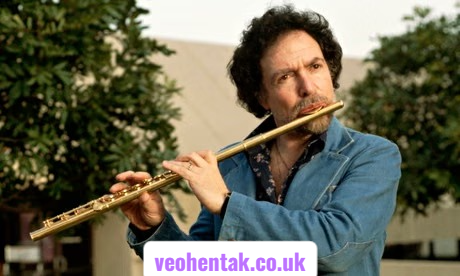Paul Horn was a groundbreaking American jazz flutist, saxophonist, and pioneer of new age music. He blended Western jazz with world traditions, especially Indian and Eastern sounds, influencing generations of musicians. His recordings inside natural spaces like the Taj Mahal remain legendary, and his career bridged improvisation, spirituality, and cross-cultural collaboration.
The story of Paul Horn is not only about music but also about the meeting of cultures, meditation, and self-discovery through sound. He began in traditional jazz but moved into experimental, spiritual, and world music forms. His work is widely considered a foundation for new age music and a global awareness of sound healing. His legacy still inspires artists, teachers, and seekers who see music as a way to connect people.
Early Life and Musical Foundation
Paul Horn was born on March 17, 1930, in New York, and grew up in a musical environment that shaped his interest in sound. He studied clarinet and flute before moving toward jazz saxophone. His education at Oberlin Conservatory of Music gave him classical training, but he also absorbed improvisational freedom. This duality—technical discipline and creative exploration—would later define his career.
In the 1950s, Horn performed with big jazz bands and worked with greats like Chico Hamilton. He quickly gained recognition for his ability to blend precision with soulful expression. Unlike many of his peers, he did not confine himself to one genre. Instead, he looked at music as a universal language.
Rise in Jazz and Early Recognition
Paul Horn earned a reputation as a skilled flutist and saxophonist in the Los Angeles jazz scene. His albums in the late 1950s and early 1960s reflected a deep respect for traditional jazz while hinting at broader experiments. He became a sought-after studio musician, appearing on recordings that showcased his technical clarity.
During this time, Horn also developed an interest in psychology and meditation, setting him apart from fellow musicians. His performances carried both the energy of jazz improvisation and a personal quest for meaning.
Spiritual Awakening and Transformation
The turning point in Paul Horn’s life came when he traveled to India in the late 1960s. Meeting Maharishi Mahesh Yogi and learning Transcendental Meditation changed how he approached music. He began to see sound not just as entertainment but as a form of healing and meditation.
This transformation influenced his compositions, which grew more spacious and contemplative. He experimented with resonance, silence, and natural acoustics, blending Eastern spirituality with Western musicianship. This was not common in jazz at the time, making him a pioneer in spiritual and new age music.
Taj Mahal Concert and Legacy
One of the most famous moments in Paul Horn’s career was his 1968 recording inside the Taj Mahal. This album, Inside the Taj Mahal, became a landmark in new age music. The natural echoes of the monument combined with his flute created a mesmerizing sound that listeners described as meditative and transcendent.
The recording was groundbreaking because it showed how music could connect with space and architecture. It influenced how future artists approached recording, emphasizing atmosphere over conventional rhythm and melody.
Contribution to New Age Music
Paul Horn is often called the “Father of New Age Music.” His approach blended jazz improvisation, world sounds, and spiritual meditation. He produced several Inside albums recorded in unique locations, including pyramids and cathedrals.
His work appealed not only to jazz fans but also to spiritual communities. He became an important figure in bridging music and meditation practices, making sound a tool for inner peace.
Collaborations with Global Artists
Throughout his career, Paul Horn collaborated with musicians from diverse traditions. He worked with Indian sitarists, Tibetan monks, and Western classical performers. His openness to cultural exchange made his music universal.
These collaborations demonstrated that sound could transcend language and nationality. Horn’s ability to weave different traditions together earned him respect among world musicians.
Bullet Point Highlights of His Style
- Emphasis on meditation and spirituality in sound
- Blending of jazz with Eastern traditions
- Use of natural acoustic spaces for recordings
- Focus on improvisation and freedom of expression
- A bridge between Western and world music traditions
Influence on Generations of Musicians
Paul Horn influenced artists from jazz players to new age composers. His fearless experimentation opened doors for musicians who wanted to explore spirituality in sound. His recordings became reference points for meditation practitioners, yoga teachers, and sound healers.
Even modern ambient and world music genres owe a debt to his innovations. By refusing to stay within the boundaries of traditional jazz, Horn created a path for future musicians seeking freedom.
Awards and Recognition
During his career, Paul Horn received Grammy Awards and critical recognition. His albums often appeared on charts not only for jazz but also for world and new age categories. This dual recognition showed his ability to appeal across audiences.
His recognition was not only in awards but also in how spiritual and cultural communities embraced his work. He became a symbol of the meeting between East and West.
Discography and Key Albums
To understand Paul Horn, one must explore his discography. Below is a simplified table of key albums:
| Year | Album Title | Significance |
| 1957 | House of Horn | Early jazz album establishing his style |
| 1965 | Cycle | Blending jazz with experimental elements |
| 1968 | Inside the Taj Mahal | Landmark new age recording |
| 1971 | Inside II | Continuation of spiritual exploration |
| 1989 | Traveler | Reflection of his global influences |
These albums show his evolution from jazz roots to meditative explorations.
Also read this:The Inspiring Journey of Collette McArdle
Personal Life and Beliefs
Beyond music, Paul Horn was a dedicated practitioner of meditation. He believed music and meditation were linked, both helping to achieve inner peace. His life reflected a balance between professional success and spiritual growth.
He also dedicated time to teaching and sharing his experiences. Horn encouraged young musicians to see sound as more than entertainment, urging them to find personal meaning.
Later Career and Global Impact
In the 1980s and 1990s, Paul Horn continued recording and performing around the world. His concerts attracted audiences who sought not only jazz but also spiritual experiences. He became a global ambassador for music as a healing art.
Horn also adapted to changing technologies, using digital formats to reach wider audiences. His timeless recordings continue to sell and inspire even decades later.
Death and Continued Legacy
- Paul Horn passed away on June 29, 2014, in Vancouver, Canada. His death marked the end of an era but not the end of his influence.
- His recordings remain essential for anyone exploring the intersection of music and spirituality.
- Today, his work is studied in music schools and used in meditation centers worldwide.
- His philosophy of universal sound continues to resonate with people across generations.
Why Paul Horn Still Matters Today
In a world searching for balance and peace, Paul Horn’s vision remains relevant. His belief in music as a unifying force inspires not only musicians but also teachers, therapists, and spiritual leaders. His journey shows that art can be both technically brilliant and spiritually meaningful.
Horn’s ability to combine tradition with innovation ensures his place in history. He showed that sound, when used consciously, can transform lives.
Conclusion
The story of Paul Horn is one of exploration, transformation, and influence. From his early jazz beginnings to his spiritual recordings inside sacred spaces, he reshaped how the world sees music. His fusion of East and West, improvisation and meditation, left an enduring legacy.
Horn was not just a musician; he was a seeker who shared his discoveries through sound. His recordings continue to guide listeners into deeper awareness. His legacy proves that music, when born from the heart, can transcend time.
FAQs about Paul Horn
Q1. What genre of music was Paul Horn known for?
Paul Horn was known for jazz, new age, and world music. He pioneered the blending of these genres with spiritual elements.
Q2. Why is Paul Horn called the Father of New Age Music?
He earned this title because his recordings, especially Inside the Taj Mahal, introduced meditative and spiritual soundscapes that defined new age music.
Q3. Did Paul Horn collaborate with other world musicians?
Yes, he worked with artists from India, Tibet, and other traditions, blending different cultures into his sound.
Q4. What role did meditation play in his music?
Meditation shaped his compositions, making them spacious, reflective, and deeply spiritual.
Q5. Where can people listen to Paul Horn’s music today?
His recordings are available on streaming platforms, in record collections, and in meditation and yoga communities worldwide.
Fore more info:Veohentak.co.uk


